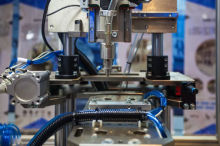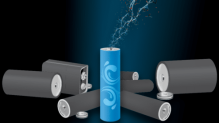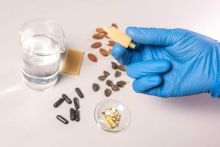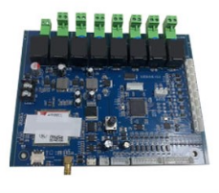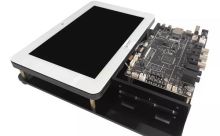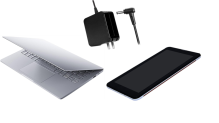Stretchable electronics uniquely match the complex geometry and compliant mechanisms of human physiology. This capability makes stretchable and flexible devices suitable for a variety of human biomedical sensing applications, such as pulse wave sensing, oximetry, and bioimpedance tomography, among others, due to their multidirectional stretchability and deformability. In addition, the conformal contact provided by stretchable materials can improve signal quality by reducing motion artifacts and can transform wearable electronics into lightweight and imperceptible devices. Liquid metals, such as EGaIn (75.5% Ga, 24.5% In) and Galinstan (68.5% Ga, 21.5% In and 10.0% Sn), Due to its high electrical conductivity (3.4 × 10⁴ S cm⁻¹) and low toxicity, it is the highest performing material for stretchable electronic device connectivity. In addition, the liquid state of EGaIn easily accommodates the cyclic loads of large uniaxial and biaxial strains required by the wearable device, without the need for a meandering serpentine structure.
The reliability and performance of liquid metal conductors are critical for stretchable wireless circuits that integrate many passive components, sensors, and integrated circuits (ics). These wearable systems can deform during normal use, including biaxial strains of up to 30 to 40% of the skin at joints such as knuckles or elbows. Maintaining these mechanical deformations allows the resistive sensing mode to convert the liquid metal trace into a strain gauge. The deformation of liquid metal flexible circuits includes in-plane mechanical stretching, out-of-plane torsion and compression modes. Although the direct current (DC) resistion-based electrical responses of liquid metal conductors to these mechanical deformation modes (reflecting the degree of strain, cross-sectional geometry, and length) are well established, their high-frequency responses to these modes have not been explored.
Alternating current (AC) resistance modulation is a promising way to extend the sensitivity and performance of liquid metal stretchable sensors by taking full advantage of the physical properties of liquid metal deformable geometric configurations. Previous research on AC based liquid metal sensing is based on the time domain sensing by reflection on the liquid metal transmission line and the change of inductance or capacitance. However, these previous studies have not examined a key feature of liquid metals at higher frequencies above 1 MHz -the cross section of deformable conductors naturally alters their electromagnetics and alters the effective resistivity at the microscale.
Understanding the electrodynamics of AC conduction in liquid metal conductors is essential for the design of complex stretchable analog circuits for sensing and communication. Specifically, high-density stretchable electronic devices with passive elements such as resistors, capacitors, conduction holes, etc. made of liquid metals by soft lithography can benefit greatly from the study of high-frequency AC resistance responses to mechanical deformations. Ac performance is also central to the use of liquid metals for applications such as wireless power transmission that are highly sensitive to resistance losses.


